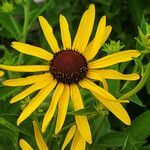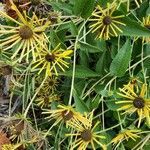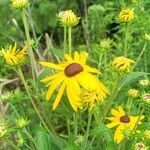Perennial from a stout rhizome; stem 6–20 dm, glabrous below, ± densely short-hairy above; lvs firm, densely short-hairy, especially beneath, ovate to sometimes lance-elliptic, petiolate, serrate, generally some of the larger ones deeply trilobed; disk dark purple or brown, 8–16 mm wide, not elongating; rays 12–21, yellow, 2–4 cm; receptacular bracts obtuse or acutish, distally viscidulous-canescent; pappus a minute crown; 2n=38. Prairies and low ground; Mich. to Wis., s. to w. Tenn., La., and Okla. July–Sept.



